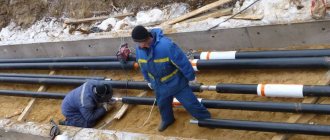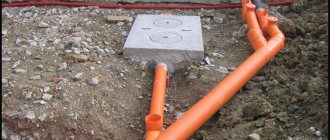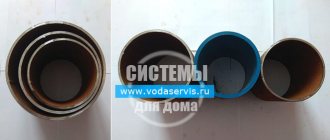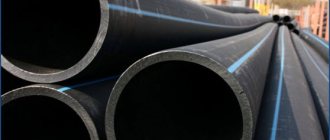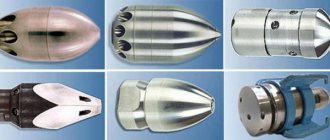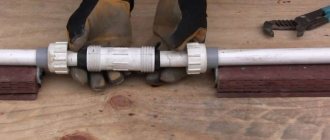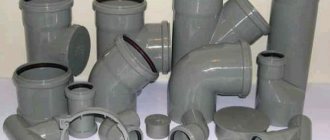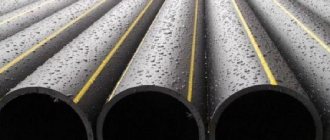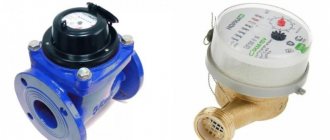What is HDPE pipe
HDPE pipes are formed by melt and continuous extrusion from granulated high-density polyethylene, the so-called low-density polyethylene (HDPE, HDPE, HDPE).
Technical characteristics and properties
Differences in ethylene polymerization technologies (temperature, pressure, component composition) ultimately determine differences in the properties of the final product. As a result, polyethylene is divided into many modifications: high, medium and low pressure polyethylene, cross-linked polyethylene, etc. In fact, their main difference lies in the structure of the crystal lattice and the density of the resulting polymers. It is this quality that determines the strength characteristics of products and their scope of application.
HDPE pipes are produced in 4 main modifications, the features of which determine the scope of their use:
- PE 100.
- PE 80.
- PE 63.
- PE 33.
The numerical index after the abbreviation “PE” indicates the stability of intermolecular bonds in plastic. The higher this value, the stronger the material.
| Technical characteristics of HDPE pipes | ||||
| Polyethylene grade | PE 100 | PE 80 | PE 63 | PE 32 (PE-1) |
| Raw material base | Excellent quality of raw materials | Recyclable PE | ||
| Minimum strength index | 10 MPa | 7.5 MPa | 6.3 MPa | 3.3 MPa |
| Density | 0.965 g/m³ | 0.941 g/m³ | ||
| Degree of crystallinity | 75-85% | |||
| Maximum working pressure | 3.3-10 MPa | |||
| Operating temperature | from -20 to +40°C | |||
| Melting temperature | 130°C | 120°C | ||
| Brittle point | -60°C | -40°C | ||
| Tensile strength | 38 MPa | |||
| Tensile strength | 9.8-16.67 MPa | |||
| Flexural strength | 11.77-16.67 MPa | |||
| Elasticity index | 117.68-254.97 MPa | |||
| Minimum elongation at break | 350% | 250% | ||
| Water absorption | 0,01% | |||
| Life time | up to 80 years old | up to 60 years old | up to 50 years | |
It should be noted that the given physical and technical characteristics are based on the general properties of low-density polyethylene, and depending on the extrusion technology and wall thickness they may vary.
Options for reliable insulation of polyethylene pipes
- Glass wool is a short-lived but affordable insulation material that requires additional external insulation.
- Basalt insulation is a more functional analogue of the previous material.
- Polystyrene foam - available in shell form, does not require additional insulation, and is suitable for repeated use.
A good option would be to purchase an already insulated HDPE pipe. This is a two-layer structure, where an insulating layer is laid on top of a plastic pipe, covered with an outer shell. However, such products are noticeably more expensive.
Read about Energoflex flexible insulation.
Features of the material, its advantages and disadvantages
The physical and chemical properties of HDPE material determine a number of its operational features that distinguish it favorably from most types of plastic, including, it would seem, from the related LDPE:
- The density of the molecular crystal lattice provides the material with high strength, elasticity and gas impermeability. It is resistant to external and internal pressure, stretching and temperature changes. These qualities make it possible to lay HDPE pipes underground without worrying about soil movements, which is why they are widely used in seismically active regions.
- The elasticity of the polymer allows it to be easily bent and, if necessary, to be installed without fittings, saving a considerable part of the budget for the purchase of connecting elements.
- The microporous structure makes the HDPE material lightweight, facilitating the delivery and installation of reinforcement. In addition, micropores absorb vibration noise created by water flow.
- Inert to most salts, acids and alkalis of both organic and inorganic origin and other chemicals. Interaction with water and oxygen does not provoke the oxidation process and does not trigger corrosive processes.
- Production technologies make it possible to achieve absolute smoothness of the surface, which improves the hydraulic capabilities of the line, and deposits do not accumulate inside and build-ups do not form.
- HDPE material is not susceptible to biological contamination; bacteria and fungi do not multiply in its structure and on the surface.
- Polyethylene belongs to the class of dielectrics, which means it is not capable of conducting electric current.
- The organic nature and absence of toxic substances in the material make it environmentally friendly and safe.
To make the picture complete, we cannot neglect the disadvantages of HDPE materials:
- The higher the density, the greater the load the material can withstand. However, at the same time, the crystal lattice becomes more fragile and susceptible to shock loads and extremely low temperatures.
- Ultraviolet rays also have a detrimental effect on the structure of the polymer, which dries out and cracks over time.
- Under the influence of high temperatures, HDPE plastic tends to soften, so the temperature regime of the carrier is usually limited to 40°C.
- Polyethylene is flammable and when burned, initially safe substances are transformed into toxic ones.
- If you install a HDPE pipeline taking into account all the shortcomings, the water supply network can last about 60-80 years trouble-free.
Technical characteristics of polyethylene products
The installation of a water supply system begins with its design. And to create such a project, you need to understand the technical characteristics of the pipes. They may vary for products of different diameters. But the melting point for all products will be the same - +120...+135°C.
All types of pipes can withstand frosts down to -70°C. The density of most products is 948-960 kg/cubic. m, and the specific heat capacity is in the range of 2300-2700 J/(kg*K). In this case, the characteristics of the required model can be found in the accompanying documentation.
Scope of application
The scope of application of HDPE pipes is determined by the brand of polyethylene (see table).
| Type of HDPE pipes | PE 100 | PE 80 | PE 63 | PE 32 |
| Pressure | Gravity | |||
| External and internal cold and hot water supply systems | + | + | — | — |
| External gas communications | + | — | — | — |
| Gravity sewers | + | + | + | + |
| Transportation of food and industrial liquids and gases | + | + | — | — |
| Pool equipment | + | + | — | — |
| Showers | + | + | + | + |
| Automation of irrigation systems | + | + | + | + |
| Protective casing (cable ducts) for fiber optic, electrical, television, telephone and other types of cables | + | + | + | + |
Scope of application of products manufactured using low pressure extrusion technology
The pipes are resistant to low-temperature effects; in extreme cases, the main line can be insulated. You need to pay attention to the upper temperature bar.
The melting point is +105 degrees, the pipe begins to soften and deform at +80 .
HDPE pipes are highly resistant to temperature changes and mechanical damage, which significantly expands their intended use. They are used:
- Electric installation work.
- Irrigation system equipment.
- Low pressure gas lines.
- Sewage systems.
- Hot and cold water supply.
- Pipelines with low burial depth.
- Wells and wells.
Product requirements
According to established standards, products must:
- Comply with sanitary, epidemiological and hygienic requirements;
- have a flat, smooth surface both outside and inside. The presence of foreign inclusions, cracks, depressions or bubbles is not allowed;
- withstand loads in accordance with the declared classes;
The ignition temperature of the material should not be lower than 300°C.
In addition, the manufacturer is obliged to include information about the purpose and technical parameters of the product along the entire length. The gap between the markings should not exceed 1 m.
Important! The method by which the marking is applied must not compromise the integrity of the pipe. Thermal embossing or painting by which the marking is applied must not cause cracking or corrosion of the material.
Requirements according to GOST
The quality of HDPE pipes of different markings must comply with GOST requirements:
- Inner and outer surfaces must be smooth. The presence of waviness should not take the diameter beyond the permissible standards.
- The end surfaces are smooth, without inclusions of air, cracks, or nicks.
- Pipe elongation is no more than 3% after heating.
- Resistance under constant pressure for 100 hours at a temperature of 20 degrees.
- At 80 degrees, all grades are durable for 165 hours at constant pressure.
- According to safety requirements, the ambient temperature should not exceed 300 degrees. The material is classified as flammable.
- Polyethylene does not release harmful toxins into the environment. No additional safety measures are required when working with it.
- The waste after installation is harmless. They are taken back to the manufacturing plant and processed.
Products are subject to preliminary testing before shipment to consumers. Non-compliance on at least one point requires modifications and re-testing.
Markings, sizes and diameters
HDPE pipes for water supply are available in a wide range of lengths and diameters (from 10 to 2000 mm):
- In straight sections, the length of products varies in the range of 3-24 m.
- In coils or coils, the length of pipes can exceed 500 m.
- With a diameter of 180 mm and above, HDPE pipes are produced only in sections.
Density of polyethylene
| HDPE | PVD | |
| Density | 910 – 925 kg/m³ | 941 – 965 kg/m³ |
Such a small difference in the density of materials is only insignificant at first glance. In fact, the higher the density coefficient, the stiffer and stronger the product, and its shell is more resistant to gas penetration.
Diameter of HDPE pipes and what is SDR
The standards indicate the following standard sizes of HDPE pipes:
- Outer diameter – from 10 to 160 (for PE 32) and up to 2000 mm (for PE grades 63, 80 and 100).
- Wall thickness – from 5 to 53.3 mm.
- Weight per 1 linear meter – from 51 g to 700 kg (for PE grades 63, 80 and 100) and from 52 g to 8.13 kg (for PE 32).
SDR is an indicator of the ratio of the outer section of a HDPE pipe to the thickness of its wall. In fact, it is calculated by the formula:
On a note! The SDR index indicates the strength of the HDPE pipe: the lower the digital code, the thicker the pipe wall, and the stronger and greater the load it can withstand.
Pipe series and pressure rating
The pressure at which plastic pipes can operate without failure, and their actual purpose, depends on the brand of polymer and the SDR value.
Regulations
The production of HDPE water pipes is regulated by GOST standards 18599–2001.
Example of PE pipe marking
The terms of GOST require the mandatory inclusion of the following data in the labeling:
- Manufacturer's name or trademark designation.
- Polyethylene class.
- SDR index.
- Standard size (section, wall thickness).
- Nominal pressure.
- Temperature regime.
- Purpose.
- GOST, in accordance with which the products are manufactured.
Additionally, the date of manufacture, batch number, certification data and other information that the manufacturer deems necessary to convey to the consumer may be indicated.
In addition to alphanumeric designations, the manufacturer is required to apply a longitudinal color marking strip, which allows you to visually determine the purpose of the pipe:
- Products intended for organizing drinking water supply are indicated in blue.
- Yellow – for gas supply.
- A pipe without a marking strip is classified as technical.
On a note! To organize hot water supply, it is better to use HDPE pipes marked “PN”. This designation indicates a multi-layer product, in which one of the layers is made of fiberglass, foil or steel mesh and serves as reinforcement.
Production of polyethylene pipes
Several technologies have been developed that, depending on a number of factors, are used in the production of parts from this material.
The following methods are distinguished:
- Suspension, in which polymerization of monomer raw materials occurs in a dispersion medium (water is used as standard). In this case, a suspension is formed with the size of individual particles in the range of 50-150 nm.
- Mortar. In many ways, it resembles the previous production method, but an organic solution is used for polymerization.
- Gas-phase technology. It is characterized by the presence of a gas phase of the monomer.
With all 3 methods, you can obtain a durable and high-quality material characterized by strong bonds between molecules. But some HDPE indicators will vary depending on the selected production technology. Although for the end user, a more important role is played by the fact that all 3 methods make it possible to obtain pipes of different sections and with the required wall thickness.
Ratio of indicators
The relationship between these 2 indicators is also important. What diameters will be chosen depends on the specifics of the project.
How to choose HDPE pipe
In addition to the fact that the surface of the plastic pipe must be absolutely smooth and even, you should check the uniformity of the wall thickness, at least within sight.
- When choosing a suitable diameter, you should focus on the diameter of the supply line. To create good pressure, it is advisable to give preference to a slightly smaller cross-section.
- For the installation of cold and hot water supply, pipes with a cross-section of 20-25 mm and a wall thickness of 2 mm are most often used.
- For watering a personal plot, pipes with a cross-section of 32-40 mm are used.
approximate cost
| Brand | Manufacturer | PE grade | SDR Index | Type | Outer diameter, mm | Wall thickness, mm | Price per p/m, rub. |
| Highway Surgut | Russia | PE 100 | SDR 11 | technical | 110 | 10 | 600 |
| Gilex | not specified | water supply | 20 | 1,4 | 21 | ||
| agro-industrial complex | SDR 17 | 40 | 2,4 | 55 | |||
| Kudinovsky Pipe Plant | SDR 13.6 | drinking | 32 | 2,4 | 54 | ||
| UPONOR | Finland | PE | not specified | 25 | 2,3 | 109 | |
| Anchor | Russia/China | PE 100 | water supply | 40 | 3 | 116 |
The best HDPE manufacturers
There are more than a hundred companies in Russia that manufacture these products. Large companies that have earned a positive reputation include:
- OJSC Kazanorgsintez, which produces more than 20% of the total volume in the state. PE-80 products are produced here in full compliance with GOST requirements. The range of products includes products for water with a diameter of 10-1200 mm and gas pipelines with a diameter of 63-315 mm.
- is located in the capital region, specializes in the PE-100 brand of gas and water pipes with a diameter of 20-1200 mm, capable of withstanding pressure of 5-25 atmospheres.
- It unites more than 10 enterprises in the CIS countries. Here you can find a wide range of products in this segment.
Domestic manufacturers produce products for the domestic and foreign markets. This product is of high quality and is very popular in our country and abroad.
All products are strictly subject to internal quality control on important parameters:
- smoothness of surfaces, uniformity of material;
- slight longitudinal waviness is possible within the standards;
- polyethylene pipe for water supply is traditionally made in black format.
The durability of the system depends on their quality; it is recommended to purchase products only from trusted brands.
How to properly connect HDPE pipes
One of the main advantages of HDPE pipes is the possibility of self-assembly, and a huge variety of fitting elements (couplings, adapters, elbows, plugs, etc. fittings) allows you to assemble a water main of any configuration.
The specificity of the material gives the user the right to choose the most convenient method of assembling the pipeline from the four currently practiced:
- Butt welding.
- Electrofusion welding.
- Via compression fittings.
- Flange connection.
The first two methods are classified as one-piece and provide the greatest strength and tightness. The last two make it possible to disassemble the connection if necessary and reassemble it again.
Permanent connection methods
Electrofusion (electrodiffusion) welding is performed using polymer thermoresistive fittings (electrofusions), on the inside of which a special heating coil is mounted. The pipes inserted into the fitting are connected due to the melting of the polymer layer on the walls of the joined parts. The welding mode is set by sensors and a bar code printed on the coupling, and is read and controlled by an electric welding machine connected to the fitting through the terminals installed on it.
Installation of a HDPE pipeline using electrofusion welding is relevant for:
- Laying a pipeline in deep soil (especially in seismically active areas).
- Connecting pipes with a cross-section over 2 cm and a wall thickness of 3 mm.
Butt welding involves the use of specialized welding equipment (soldering iron), which melts sections of HDPE pipes. Then these ends are connected to each other. This method will require careful preparation and development of the “gluing” skill. The ends of the joined sections must be cut perfectly evenly (at an angle of 90°C), and when combining the molten ends, it is important to control the degree of pressure and avoid turning the parts.
Important! Due to the flow seam formed by the melted plastic, the throughput of the water main is reduced. Therefore, butt welding technology is not used for HDPE pipes with a cross-section of up to 50 mm.
The use of detachable connections when installing HDPE pipelines
The compression type of connection is perhaps the most popular in the field of private construction, but it is recommended exclusively for cold water supply systems. Compression fittings, the key element of which are crimp nuts, not only provide a reliable connection, but also allow you to switch to a threaded connection, which is so necessary when connecting to a metal line.
Flange technology for assembling HDPE pipelines is rarely used in private construction. But in cases where it is necessary to make a threadless transition to another type of pipe, this connection method is considered indispensable. In fact, a flange (an end element in the form of a round or rectangular plate with holes for bolts) must first be welded to the joined sections using one of the above methods, then the pipes are pulled together using these flanges. For tightness, a rubber gasket is placed between the flanges.
Important! Due to the need for systematic preventive inspections, pipelines installed using compression or flange methods cannot be immersed in the ground.
DIY installation features
Comparing the costs of installing a steel and HDPE pipeline, the latter allows you to save up to 40% of the family budget, primarily due to the ability to do the work yourself and without the use of expensive equipment.
The use of polyethylene pipes is also relevant in cases where it is necessary to replace an old water supply system. The flexibility of the products makes it possible to simply stretch them inside the failed pipeline, which will also provide additional protection for the new pipeline.
Rules for installing polyethylene water supply
By adhering to a few simple rules, you can easily arrange a water supply circuit from HDPE pipes yourself:
- Before starting work, it is necessary to create a design diagram of the future water main. It will help you determine the required quantity and size of pipe material and fittings.
- When laying a pipeline in the ground, a trench should be prepared in advance:
- It is advisable to place the depth of the ditch below the soil freezing level, otherwise thorough insulation of the main along its entire length will be required.
- The width of the trench should be 4 cm greater than the diameter of the pipe: 2 cm on each side.
- At the bottom of the ditch, a drainage “cushion” of sand or a mixture of sand and gravel is installed and compacted with a layer of 10-20 cm.
- The soil in direct contact with the pipeline must be cleared of objects that pose a potential risk of damage.
- To reduce the load exerted by the thickness of the earth on the highway, it is advisable to use a protective box that will combine the functions of protection and insulation.
- When laying a polyethylene pipeline on the surface, it should be protected from harmful ultraviolet radiation. Insulation will also extend its service life.
- If it is necessary to bend a rigid pipe, the latter must be preheated using a hair dryer.
Advantages of pressure water pipes made of polyethylene
Pipes made of polyethylene of this type have a number of advantages compared to such traditional options as products made of cast iron, metal or even concrete.
Their advantages include:
Advantages.
- long service life - if all conditions are met, it is 50 years;
- resistance to corrosion and aggressive chemical influences;
- low cost;
- good elasticity;
- ability to withstand changing soil load;
- frost resistance, due to which such products do not require additional insulation (pipes can withstand low temperatures down to -70°C);
- light weight - pipes made of low-density polyethylene are lighter than products made of metal alloys (3-4 times);
- high installation speed and simplicity;
- high degree of environmental safety - pipes do not emit toxic substances and do not harbor pathogenic microbes.
In addition, HDPE pipes with a diameter of 2-11 cm are produced in coils, the total length of the products can be 50-1000 m, which helps reduce material consumption.
Such characteristics make HDPE structures a good choice for water supply systems for a summer residence. Moreover, they can be installed independently, although you will need a special device.
The operational and hydraulic properties of the system will be preserved even when using HDPE pipes with a diameter less than the design one. This is achieved due to the low roughness of the internal surface. The risk of water hammer for the products remains low.

